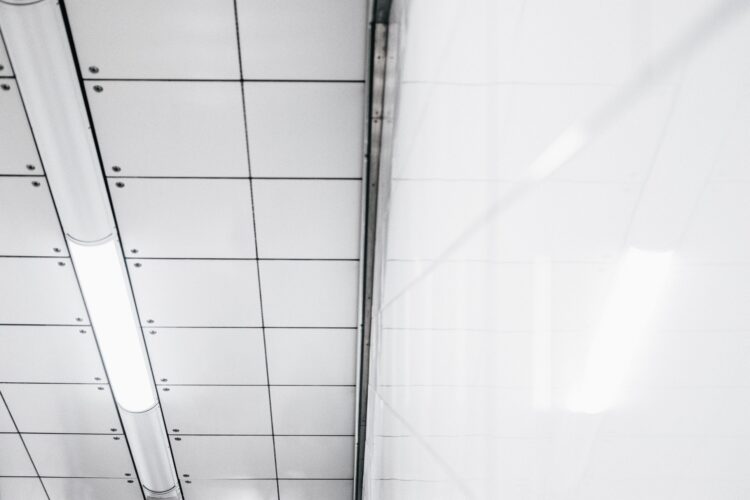
How safe are suspended ceilings?
When installing any new structural feature, safety is essential — especially in commercial spaces where you need to adhere to health and safety standards. Suspended ceilings (also known as false ceilings or drop ceilings) can be a fantastic addition to any office, retail space, or other public building. But how safe are they?
Read on for all you need to know about suspended ceilings and health and safety.
Are suspended ceilings fire-safe?
No matter what building you’re fitting out, fire safety should be a key consideration of any design. Not only will using fire-rated materials lower the risk of injury and destruction, but it also ensures compliance with fire safety legislation. Without adhering to these standards, you could face fines and prosecution.
These days, suspended ceilings must be fire-rated to withstand 300 degrees of heat exposure. A fire-rated false ceiling can also provide additional passive fire protection by creating an extra barrier or compartment. This prevents flames and smoke from reaching the main fabric of the building. When certified, installed and maintained to a high standard, drop ceilings can provide up to four hours of passive fire protection.
As leading suspended ceiling fitters in the South West, the team at SLP Interiors is committed to only using secure, fire-rated materials.
If you’re planning on fitting suspended ceilings, it’s important to speak to the installation team to discuss any existing fire safety features the drop ceiling might affect. For instance, if your building has a ceiling sprinkler system, you’ll need to carefully plan the false ceiling construction to incorporate this.
Are suspended ceilings prone to mould?
If you’ve ever spent a prolonged period of time in a building with mould, you’ll know that it can be both unpleasant and pose health risks. “Sick building syndrome (SBS)”, refers to building occupants experiencing poor health or discomfort linked to the space itself. Symptoms can range from headaches and dizziness to nausea, itching, and coughing. SBS is common in open-plan offices, and studies suggest that, in many cases, mould could be the cause. Mould spores can be distributed in the air — particularly in spaces with little natural airflow from open windows.
Improving ventilation and tackling the source of the mould can help relieve symptoms. Because suspended ceiling tiles tend to be fairly porous, they can be prone to mould — so this is something to keep in mind. However, at SLP Interiors, we use specially-designed waterproof ceiling tiles to avoid this issue.
Do suspended ceilings affect air quality?
As mentioned, porous suspended ceiling tiles can be prone to mould and bacteria. Many offices, retail units, and hotels rely on air conditioning for ventilation. Unfortunately, this tends to recycle the air and can spread mould and bacteria particles. Throughout the day, this can create a breeding ground for microbes and reduce air quality.
Luckily, there is a way to combat this. At SLP Interiors, we can install humidity-resistant tiles to minimise the growth of mould and reduce the risk of poor air quality. It’s important to note that, even with humidity-resistant materials, you may need to clean your suspended ceiling tiles semi-regularly to keep them free from bacteria. Metal or vinyl ceiling panels are your best bet in spaces with air conditioning.
In contrast, there are some situations where suspended ceilings can actually improve air quality. If your building is located in an area with high air pollution levels, a false ceiling can act as an extra barrier to keep pollutants out.
If you have any questions about suspended ceilings and air quality, feel free to get in touch with the SLP Interiors team — we’d be happy to help.
Suspended ceilings: additional health and safety considerations
Before arranging false ceiling installation, here are a few extra factors to consider:
- Will your suspended ceiling be concealing any electrical components or wiring? If so, speak to the installation team to make sure you can access them for maintenance.
- Always hire a professional to install your drop ceiling — it needs to be secure.
- Carry out a risk assessment to ensure a suspended ceiling is suitable for your building.
- Remember, suspended ceilings must adhere to the BS EN 13964 standard.
Suspended ceilings from SLP Interiors
Whether you’re planning to install a false ceiling in a school, hotel, supermarket or office, the safety of the building’s occupants should be front and centre. AT SLP Interiors, we have the training, experience and knowledge to ensure your drop ceilings adhere to health and safety requirements and are installed to the highest standards. We’re accredited by Chas and Constructionline, and all of our operatives hold CSCS NVQ level 2 qualifications. We only work with manufacturers that provide fire-rated materials and can collaborate with you to incorporate any fire alarms, sprinklers, CCTV units or other safety equipment needed.
Take a look at some of our previous projects to see what we can do. To learn more and to discuss your suspended ceiling requirements, please feel free to get in touch via our contact form or give us a call on 0117 214 0852.



